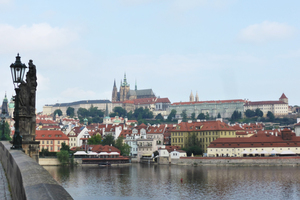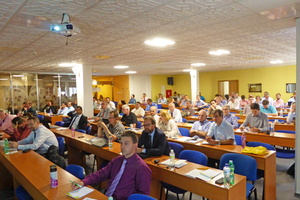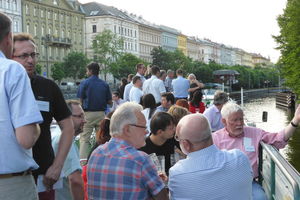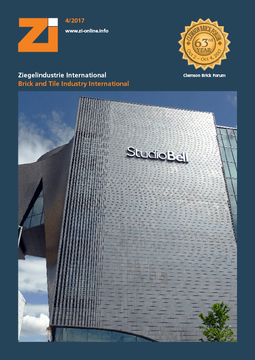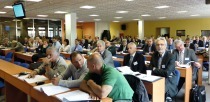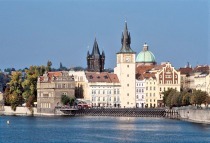Hot topics in refractories discussed at Refra Prague
Michal Přibyl, President of the Czech Ceramic Society, welcomed the around 130 attendees in “really fitting, hot weather” to enjoy an informative programme with more than 30 papers. Topics included refractories for cement, steel and various furnace applications. In one part of the papers, different types of refractories for different applications were presented. The numerous academic representatives from research and development reported on their latest findings. Freiberg University of Mining and Technology was represented with several papers and addressed amongst other things the influence of particle size on the properties of uniaxially pressed refractories and the corrosion of aluminium-based refractories by coal and biomass ashes. Other topics from the academic field included thermal shock resistance and the application of various analysis methods.
Friedrich Raether, Fraunhofer Centre for High-Temperature Materials and Design HTL, showed how research also contributes to the development of new measurement systems. He presented various measurement methods for the high-temperature properties of ceramic materials, including refractories. The thermooptical measurement methods employed by Fraunhofer are part of a series of TOM measurement devices developed by the Institute, which are steadily further developed there. Besides optical properties, such as sample dimensions and e.g. thermal expansion during preheating/cooling, chemical processes, gas separation and mass changes can be analysed. For the end of 2017, a new module is planned, which can be used especially in ceramics. This will be used to record mechanical properties, e.g. strengths, as a function of temperature. The measurement systems that can be put together from different modules can work in up to 1800° C depending on the application.
Another development interesting for the refractories industry was reported by Frank Appel, Hans Lingl Anlagenbau und Verfahrenstechnik GmbH & Co. KG. When materials containing poreformers are used, decomposition of these poreformers during firing also has a great influence on the quality of the products. In the case of additions of high amounts of organic constituents, in the worst case, firing can become uncontrollable. In the scope of a research project, Lingl has developed Porocontrol technology in order to ensure controlled burnout of organic components. The new system is already being used in the clay brick and tile industry. How far it can be used in other industries must be clarified for the specific application.
Eckhard Rimpel, Brick and Tile Research Institute Essen Regd (IZF), showed in his keynote paper extensive possibilities for saving energy in existing plants, e.g. with the reduction of waste energy and its utilization. Possibilities include the use of recirculating fans in the preheating zone, the utilization of the humid dryer waste air and the reduction of exit losses. In a research project, the IZF is planning to investigate how an increase in the heat transport in the cooling zone can be realized.
Pavol Šajgalik, President of the European Ceramic Society (EcerS) and the Slovak Academy of Sciences, reported on the work of the non-profit organization on European level. Founded in 1987, ECerS has been officially registered as AISBL since 2013. Focuses of its work are further training and research in the field of ceramics, the organization of conferences and the publication and dissemination of technical articles. The latest of its four working groups is “Young Ceramists Network”. Every two years, EcerS organizes a conference on European level. The next one took place from 9 to 13 July in Budapest, Hungary, where young ceramists reported on their research findings.
In a keynote paper, Stanislav Dvořák, PD Refractories, answered the question: “What is the future of refractories?”. The fact is that China with a share of around 68 % (2014) dominates the refractories market. Trends in the industry included market concentration, dumping prices owing to overcapacities, focus on environmental protection and the use of renewable energies as well as the use of recycled materials and alternative raw materials. The refractories branch should, he appealed, concentrate on not only being product supplier, but a supplier of technical solutions and know-how. In many industries, too, the users were reducing personnel. Without the knowledge of quality standards and the optimal application of refractories, price becomes the deciding factor for the user. In the past, the refractories branch has made enormous achievements in development, in the glass industry, for example, the lifetime of furnaces had been increased by 60 to 80 % and by recycling an extensive contribution had been made to environmental protection. But if only price matters, Dvořák sees a decline in innovation. To counter this, closer cooperation between raw material suppliers, research institutes, refractories manufacturers and users is necessary.
On a group boat’s tour in bright sunshine on the River Vltava on the second evening of the conference, the attendees had the opportunity to discuss their experiences.
Michal Přibyl invited all attendees to the 20th Refra Prague, which will be held in either 2019 or 2020.
www.silikaty.cz

